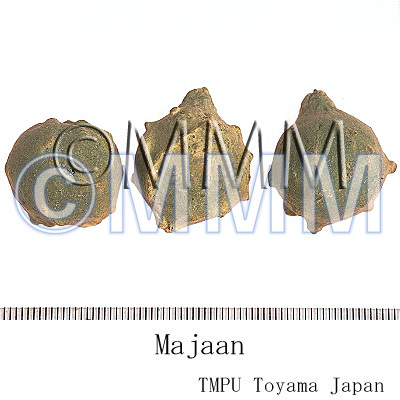Crude drug sample data base
※Click on the image to enlarge it.
Scientific information data base
| Crude drug name | Indonesian name, English name | Biji majakan, Oak gall nut | |||
|---|---|---|---|---|---|
| crude drug image |
| ||||
| Original plant name | Quercus infectoria Oliv. | ||||
| Family name | Fagaceae | ||||
| Used part | Galls | ||||
| Distribution area | Oak galls comes from oak trees indigenous to the geographic region bounded by the Black Sea to the north, the Mediterranean Sea to the south, the Aegean Sea to the west, and the bulk of the Asian mainland to the east, Perisia, Armenia and Greece. | ||||
| Description | Galls are small fruit-like material with sharp torn. Its formation, chiefly with Quercus infectoria, is caused by the activity of an Cynipid fly called Cynips tinctoria. The plant is a small tree or shrub with glabrescent leaves with spiny teeth. The bark and acorns of the tree are astringent. Flowers are monoecious. | ||||
| Drug effect | Astringent, antiseptic, hemostatic [231]. | ||||
| Specific actions | Astringent [231]. | ||||
| Frequency in use | Moderate. | ||||
| Pharmacological effect | Evaluation on the effect of alcoholic extracts of Q. infectoria galls on various in vivo and invitro experimental models of inflammation showed that the extracts exhibit in vivo anti-inflammatory activity after oral or topical administration [PMID: 15013194]. Anti-amoebic effects of crude methanol extracts of Piper longum fruit, Piper sarmentosum root and Quercus infectoria nut gall against Entamoeba histolytica infecting the caecum of mice were studied. Extract of Quercus infectoria nut gall at a concentration of 500 and of 250 mg/kg per day cured 26 and 13% of mice, respectively. The severity of caecal wall ulceration was reduced in mice which received the extract and metronidazole as compared to the control animals [PMID: 15120461]. Study on Quercus infectoria nut gall uses two fractions, a dried acetone-treated methanol extract dissolved in water (Fraction A) and a subfraction prepared by chloroform-methanol extraction (Fraction B). Fraction A was active as an analgesic in rats and significantly reduced blood sugar levels in rabbits. Fraction B had CNS depressant activity. Fraction B exhibited a moderate antitremorine activity by causing a delay in the onset and a decrease in the severity of tremorine-induced tremors [PMID: 1032663]. | ||||
| Medical system | Indonesian medicine (Jamu) | ||||
| Traditional usage | Galls produced on the tree are strongly astringent and can be used in the treatment of haemorrhages/hemorrhages, chronic diarrhoea/diarrhea, menstrual disorders, excessive leukorreal/leucorrheal discharge, hemorrhoid and dysentery [222]. | ||||
| Formulation | 1) Excessive leukorrheal/leucorrheal discharge: 5 grams of fresh fruit peel of Punica granatum, 6 grams of fresh Pluchea indica, 5 grams of the aboveground parts Elephantopus scaber, 1 gram of gall (Q. infectoria) are boiled with 110 ml of water, stand to cool, strain. Drink 100 ml of the decoction once a day for 14 days [231]. | ||||
| References | Reference book Tips! | [222] P.T. Eisai Indonesia: Medical Herb Index in Indonesia (Second edition).1995. p 134. [231] Soedibyo, Mooryati: Alam Sumber Kesehatan: Manfaat dan Kegunaan (Natural resources for health. Benefits and uses). Balai Pustaka. 1998. p 255. | |||
| Research paper | 1. Sawangjaroen N, Sawangjaroen K, Poonpanang P. Effects of Piper longum fruit, Piper sarmentosum root and Quercus infectoria nut gall on caecal amoebiasis in mice. J Ethnopharmacol. 2004 Apr;91(2-3):357-60. (PMID: 15120461) 2. Kaur G, Hamid H, Ali A, Alam MS, Athar M. Antiinflammatory evaluation of alcoholic extract of galls of Quercus infectoria. J Ethnopharmacol. 90(2-3):285-92, 2004. (PMID: 15013194 ) 3. Dar MS, Ikram M, Fakouhi T. Pharmacology ofQuercus infectoria. J Pharm Sci. 65(12):1791-4, 1976. (PMID: 1032663) | ||||
| Last renewal date | 2025/04/30 | ||||




